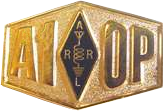|
This page contains some photographs and descriptions of the construction of my 6-band Hex Beam.
Please note that each image on this page is linked to a larger, high-resolution,
image. Smaller images are displayed here to enable faster loading. Clicking on any
image will result in a high-resolution image opening in a separate browser window.
Leo Shoemaker, K4KIO,
maintains an outstanding website that contains step-by-step construction details.
Leo's site and instructions were my constant companion throughout the construction.
I will not even pretend to provide the level of detail that Leo provides, but did want
to post some pictures of what I did and what I learned during my project.
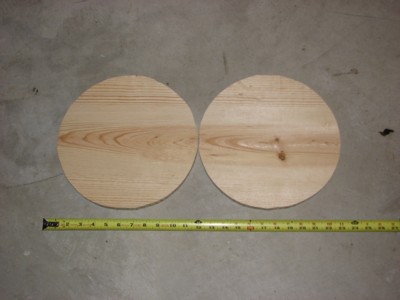
In my opinion, the most important and most critical part of the construction project
is the construction of the "Base Plate". The Base Plate is the part of the Hex Beam
that acts as a hub, or spoke, to hold the spreader arms and also attaches the entire
antenna to the mast.
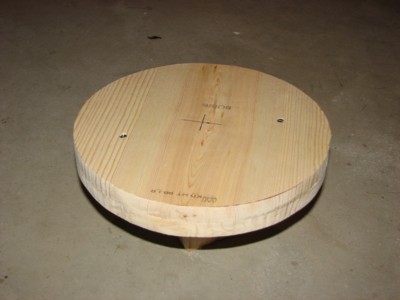
Various materials have been used to construct base plates and I suspect that the
most enduring material would be aluminum. In my case, however, I selected to make mine
out of wood and seal it well with several coats of good quality paint.
I started with a 10-1/2" wide board and cut two maximum diameter circles. The two
circles were then glued back-to-back and allowed to dry for a few days before continuing.
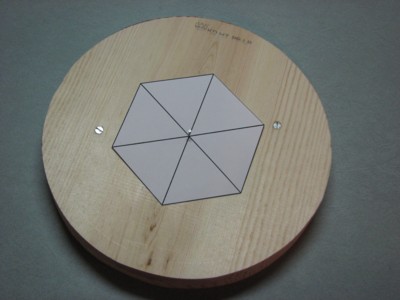
Once the base plate material is identified and cut to size, the next essential step
is to determine the position of each of the six spreader arms. The six arms need to be
spaced exactly 60-degrees apart.

There are various ways of completing this task, but I found it very easy to create a
perfect hexagon on my PC, print it out, and use it as a template. Once the template was
"pinned" to the center of the circular base plate, a few lines drawn with a sharpie pen
created the six lines required.

Once the lines are drawn to identify where the spreader arms will be attached, the next
step is to drill a hole for the center support post. One of the most popular construction
materials for the center post is thick-wall PVC pipe available at most local hardware
stores. I drilled the center post hole with a hole saw that was just slightly smaller than
the center post and then slowly hand sanded the hole to provide for a very tight fit between
the base plate and the center pole.
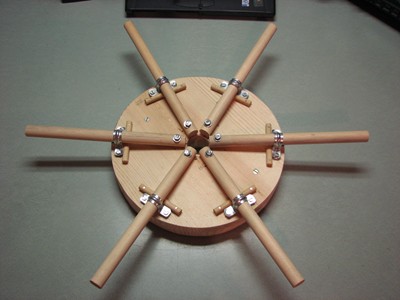
There are about as many ways to attach the spreader arms to the base plate hub as there
are ways to make a base plate. The three basic concepts are: (a) Attach the spreader arms
directly to the base plate; (b) Provide a hollow tube into which the spreader arms can slide;
or (c) Provide a rod onto which the hollow spreader arms can slide.
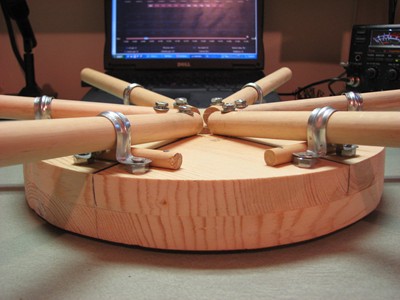
I borrowed an idea from
Leo Shoemaker, K4KIO,
to have the spreader arms slightly
angled upward. My experience in building two Hex Beams is that the actual bend shape is
quite crucial. Since the different length elements are strung between the bent spreader
arms, one common problem in Hex Beam stringing is that the higher frequency (shorter length)
elements tend to end up being very close to each other and cause unwanted interaction and
detuning. Leo's idea was to provide the spreader arms with a slight upward angle at the
very base and hope the the 12M and 15M elements would have some additional separation.
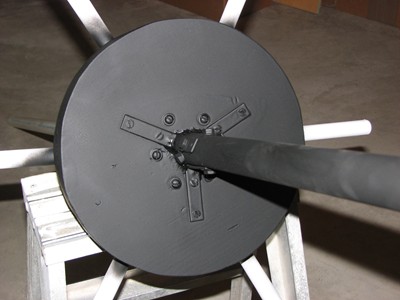
I attached the base plate to the center post using three 3-inch x 3-inch "L" brackets
from the local Ace Hardware Store. A few more coats of glossy black paint and the antenna
construction is ready to start.

From personal experience, I strongly recommend a very modular approach throughout the
entire construction process - always leave yourself an option of changing any particular
piece later on. In this specific design, for example, I found that the wooden dowels as
spreader support arms was a bad decision. Within two months of being in the air, the wooden
dowels had absorbed moisture trapped in the fiberglass spreaders and rotted.
Luckily, it was a relatively easy repair that was completed without the need to even
lower the antenna to the ground. From the rooftop, I was able to detach one spreader at a
time and replace the wooden dowel with a metal tubing made from 3/4-inch EMT conduit.
The fiberglass easily slipped over the EMT conduit and all six spreader spokes were replaced
during a single weekend project.
Once the baseplate is completed, the Hex Beam construction project is far more than half
complete. It's now time to move the project outdoors - you will need an area at least 20 feet
in diameter that is clear of all obstructions. Both of my Hex Beams have been constructed in
my back yard. I start with a very strong post solidy planted in the ground that serves as the
antenna mast during construction.
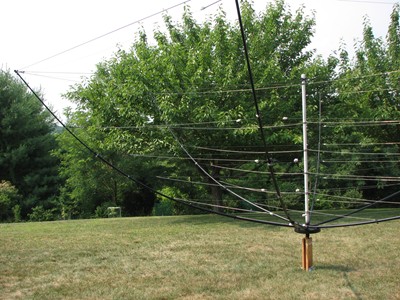
Once the base plate is mounted to the temporary mast, the fiberglass spreaders are attached
to the base plate and precisely cut lengths of dacron rope are used to form the six spreaders
into the "inverted umbrella" shape. The process of doing this is very well documented on Leo
Shoemaker's website and I can not imagine stringing the elements without first using Leo's
method to form the basic shape.
I used a total of twelve (12) dacron ropes pieces, each 124" in length. Six peices are
used to tie each spreader end to the top of the center post. Six more pieces are used to
tie each spreader end to the two adjacent spreader ends. The twelve pieces of dacron rope
form a perfect hexagon and hold the spreader in the proper shape for threading the wires
that make each element.
As mentioned previously, one common problem with multi-band Hex Beams is that sometimes
elements for adjacent bands end up being too close together and result in undesirable
interaction and detuning. The most common elements involved in this problem are the 12M and
15M elements. In nearly all Hex Beam designs what happens is that the parabolic shape of
the bent spreader arms results in a lower slope angle close to the base plate and a larger
slope angle near the top. As a result, when stringing wire between the center post and the
spreader arms, the shorter-length elements (located further down the center post) tend to
have very little vertical separation.
If you've ever strung wires in a Hex Beam, you will immediately understand the dilemma,
if not, you may have to visualize the "inverted umbrella" shape or study some of Leo's
diagrams. I ran into this problem with my first Hex Beam and stopped stringing elements
after stringing the 20M, 17M, and 15M wires. In my second Hex Beam, I wanted to find a
solution to this problem.

After conferring with
Steve Hunt, G3TXQ,
I decided to try what I believe to be a unique
approach to solving the problem. I asked myself "why do I have to run the wires all the way
to the spreader arm? What if I strung each wire at the desired vertical position and
just suspended the elements within the parabolic frame using dacron rope to tie
the element knees and ends to the closest spreader arm?" Click on the picture to the right
for an exploded view of the suspended elements.
The result worked well for me. The 20M, 10M, and 6M elements are strung between
the center post and the spreader arms and the 17M, 15M and 12M elements are suspended within
the parabolic shaped frame. Each band tunes to a reasonable SWR and on air testing shows
a reasonable front to back ratio.
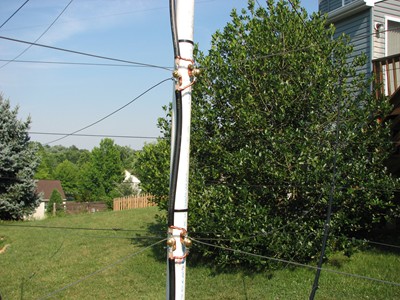
My main recommendation once you get to this point is patience, patience, patience. Use
temporary methods to attach the various element wires to the center post and the spreader
arms. Once you get the adjustments "close", then start moving an inch or so up, down, in,
out and keep making sure each element is fairly straight and level. It takes a while, but
patience really pays off.
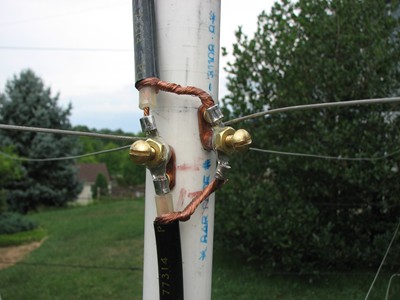
Once you get the entire structure fine tuned and tweaked just right, it's time for the
final assembly. The elements need to be permanently attached to the center post - this method
also is copied from K4KIO's step-by-step instructions. Once the elements are connected to the
center post, the final step is to interconnect each set of elements to a common feedline.
This Hex Beam is fed at the top 20M element with good quality RG-8 Coax.
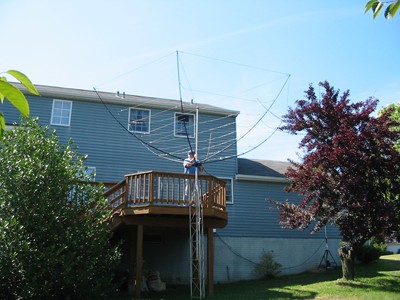
The final step was to put the completed Hex Beam about 10 feet above ground and fine tune
each band. I found it easy to slip the Hex Beam atop an unused 10' section of aluminum tower
and work on the elements from the comfort of my back deck. I used a 5-foot step ladder
to work on the upper elements.
Steve Hunt, G3TXQ,
has done more modeling and experimenting with Hex Beam tuning methods than anyone else that
I have run across. Steve's advice was essential to me throughout the final tuning steps.

Here is the completed Hex Beam waiting for me to find the right weather to carry it up
to the rooftop where it would sit atop a mast. Note a 1:1 coax balun made from about 10 wraps
of coax in a 6 inch diameter.
My experience with the Hex Beam has been very pleasant. It stands up well to both summer
and winter weather and storms and is easily rotated with a light weight rotator.
|

